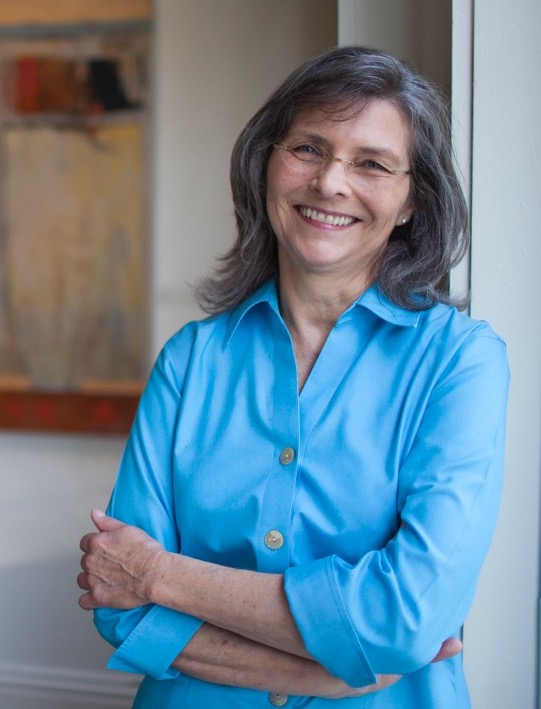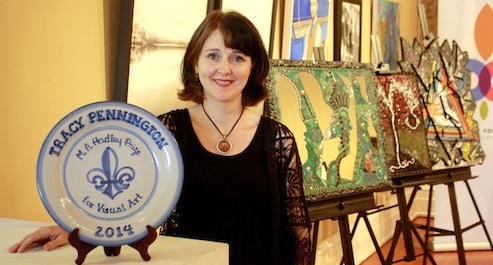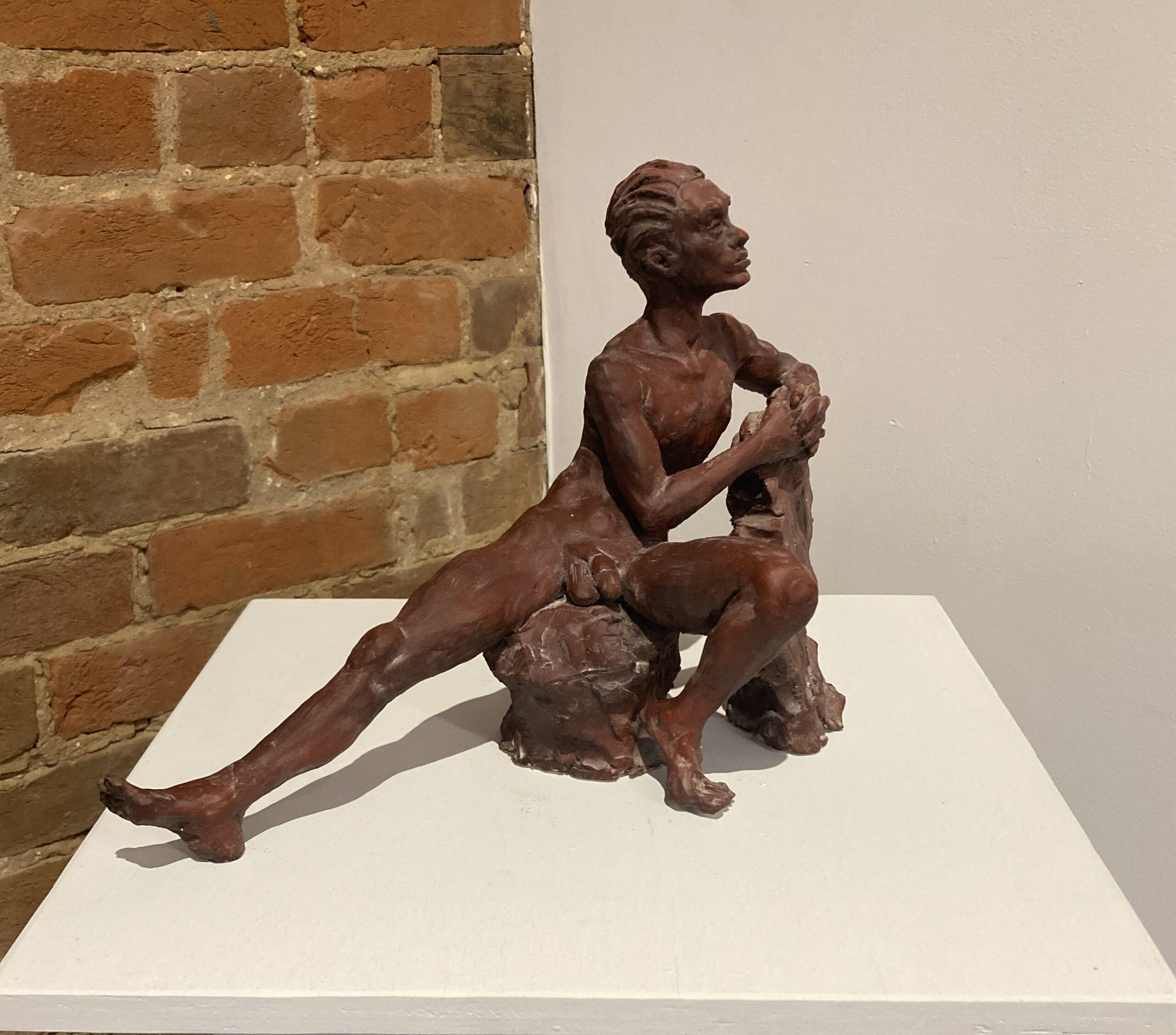Daniel Pfalzgraf at the Carnegie Center with artists Nathaniel Donnett and Vadis Turner. Courtesy D. Pfalzgraf
Daniel Pfalzgraf Buys B Deemer Gallery
Interview by Keith Waits
Entire contents are copyright © 2021 by Keith Waits. All rights reserved.
A few years ago I said to people that I thought Daniel Pfalzgraf was a leader for his generation of artists; a figure like John Begley, who helped shape the visual arts culture in the surrounding area with humility and ingenuity. Pfalzgraf has exhibited as an artist, but his work as an independent curator put the spotlight on the street art and skateboard aesthetic of young artists, and he brought some of that same appreciation for less traditional forms while working as Curator for The Carnegie Center for Art & History in New Albany. Now he has stepped into the private, for-profit gallery world by purchasing B. Deemer Gallery from Brenda Deemer, who has retired after more than 30 years.
Do you have a name and opening date? Will you be doing many renovations?
We are up and running now. Most people won’t notice too much of a difference, at least for a while. The business is listed as WheelHouse Art, LLC, but for the next year or so, we’ll continue doing business as B. Deemer Gallery.
Brenda Deemer has done such an amazing job building a successful business. There can’t be too many people around who can say they owned and sold an art gallery after 30 years of business. She has really developed a strong customer base, and I don’t want to lose those clients by making so many sweeping changes that they no longer recognize the business.
We’ll begin seeding WheelHouse Art services into the communications so clients will make the connection between that name and B. Deemer Gallery. Eventually, the current client base will automatically associate the two and everything will be absorbed under the WheelHouse Art name.
I plan on eventually looking for ways to utilize the physical space that is more conducive to the business operations, but for right now, I’m just trying to get things all setup and in order, and building some capital before taking on any of the many projects I’d like to do for the gallery.
Has owning and operating your own gallery always been an ambition? When did you first think of doing it?
Yeah, it really has been a dream of mine for a very long time. The first time I remember thinking of it I was about 12 years old. I was with my sister who was about 17 at the time while she filled out a job application, and a question on the application asked, “What is your dream job” or something to that effect, and she wrote “Gallery Owner.” Up until that time, I never even considered that that was something that people actually did, that that was something that was possible to do.
Back around 2005, 2006 I was working at the Speed Art Museum. I was doing a few side jobs for Brenda, helping to move and install art, that kind of thing. One day she called me up and asked if I would like to come work for her. I went in to talk to her about the job and told her that owning a gallery one day was a goal of mine. She said that eventually, she’d be looking to retire, so there might be something we could do down the road where I take over the gallery, so that’s why I decided to go work for her. She was very good about introducing me to clients and helping to teach me about the business
It’s kind of ironic that I was working at a museum again (Carnegie Center for Art and History) when she called me to say she was ready to retire and asked if I’d be interested in buying the business. So that’s twice now that Brenda Deemer got me to leave a museum to come work at B. Deemer Gallery.
A few years back I decided to go back to school and earn an MBA degree. I was working at the Carnegie Center and my thought was I could use it to either become a director for an existing arts organization, or I could use it to own my own art business. In the end, this opportunity came up, and I decided to invest in myself with a business rather than waiting for someone else to decide when I could make the jump to leading an organization.
How concerned are you about making this move during a pandemic?
There is definitely some concern. It is something that I had to work out with my projections for the business, what I could afford to do, and how much I would be willing to pay for the gallery.
But, this also isn’t something that I am starting from scratch. I wouldn’t feel confident leaving a safe, stable job to build something from the ground up. There is already a business that is running with materials, equipment, suppliers, and clients in place. All I have to do is jump in and try not to screw anything up too much. The gallery has actually been doing really well for the past six months, so *knock on wood* we can keep the momentum going
It cannot be overstated how much Brenda’s history and success played into the comfort level for my wife Kirsten and me with making this change happen.
It is also a time of economic uncertainty. How do you assess the marketplace for selling the work of local artists?
The art marketplace, especially for Louisville-based artists, has always been uncertain.
With very few exceptions, a local artist is highly unlikely to be able to make a living selling art in this market alone. It’s just too small. Honestly, there are few, if any, art galleries that can survive solely off art sales in Louisville. Most galleries here support their business by earning income from rentals, framing (like B. Deemer Gallery), artist dues, selling other goods and gift items, or the owners already come from a financially stable background.
You can’t sell art to only buyers in Louisville and survive. If an artist, or a gallery, wants to survive and grow through art sales, they have to expand their market. That means either physically delivering and selling art in other locations, or using digital resources to sell to people in other markets. The most successful artists from Louisville are the ones who have been able to sell to other markets.
I have a personal mission that has guided everything that I have done since I was in school, and that mission is to expand the understanding and appreciation of contemporary art with more people. I love art. I love making it, I love looking at it, I love sharing the experience with others. I started out following that mission as an artist making immersive installation work, and continued by expanding audiences’ experiences as a curator. Now that I am a business owner, my mission is driving me to do two things: 1) expand the number of local collectors by making it easier to buy and sell art, and 2) expand the number of collectors who recognize the value of buying art from Louisville who isn’t from here. We need to create an environment that makes it both easy and desirable to buy art by artists from Louisville. If the artists get more support, their work will get more recognition which leads to an increase in value, which means the local collections will grow in value, too. It’s all interconnected, and it’s in everybody’s best interest that the artists here are supported, grow, and thrive.
You worked for B. Deemer several years ago, and your identity as a curator has been primarily about promoting the exposure of unconventional work. Will the new gallery’s focus be less commercial than B. Deemer was
Yes and no.
My job as a curator followed my mission of growing understanding and appreciation of contemporary art with wider audiences. And working at the Carnegie Center really was the perfect space to fulfill that mission. They have a wide spectrum of visitors there, some who have extensive education in art and come expecting quality work, and they have some who come for the history exhibitions and programs and couldn’t care less for contemporary art. I felt my job was to serve both equally. I had to provide something of interest for those “in the know,” but I also had to provide something that could potentially interest the uninterested. What I showed there had to be of high quality, it had to catch visitors’ attention, and it also had to have some kind of relevance to everyday life experiences. That meant that I didn’t want to go too far off into the purely conceptual side of things and alienate the casual viewers. In many ways, how I served the audiences at the Carnegie Center isn’t so different than how I need to serve collectors through a commercial gallery.
If we want people to appreciate and support artists, we need to provide them with art that can connect with them. Collectors need to feel like they are a part of the experience, that they are contributing to the culture. The gallery will need to serve both seasoned collectors and new art-curious audiences.
For the past 30 years, B. Deemer Gallery has provided a safe space for a lot of collectors who have supported a lot of artists. There is no reason why I would want to stop providing that same level of engagement, and I want to continue those connections that the gallery has developed between artists and collectors. I want to grow the culture, and you can’t grow if you don’t build on what you have.
But growing means tending your current relationships as well as cultivating new relationships. So, I will plan on expanding the art offered to serve broader audiences. I wouldn’t say the new artist’s work will necessarily be less commercial, just that the work will appeal to different audiences than have traditionally supported B. Deemer Gallery

How far out have you planned an exhibition schedule?
I honestly haven’t planned out an exhibition schedule at all. I will just be rotating work by artists that already have work at the gallery for a while. Once I get a good rhythm going, when I’m thinking less about all the new things I have to learn about running the business, then I will begin to incorporate new work into the mix, probably beginning in about six months.
Until we are free to gather socially and celebrate with receptions, I don’t see much of a need to create “official” exhibitions. I will still be featuring collections of work by artists in the space to provide more casual, personal experiences that will encourage more frequent drop-in visits.
Fingers crossed that vaccines and a mass social consciousness movement of responsibility will take hold and turn things around sooner rather than later, and then I can begin scheduling exhibitions so we can all party together again. Maybe that will start happening in nine to 12 months? Stay tuned.

Keith Waits is a native of Louisville who works at Louisville Visual Art during the days, including being the host of LVA’s Artebella On The Radio on WXOX 97.1 FM / ARTxFM.com, but spends most of his evenings indulging his taste for theatre, music, and visual arts. His work has appeared in LEO Weekly, Pure Uncut Candy, TheatreLouisville, and Louisville Mojo. He is now Managing Editor for Arts-Louisville.com.







